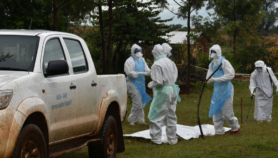By: Ogechi Ekeanyanwu and Jackie Opara
Send to a friend
The details you provide on this page will not be used to send unsolicited email, and will not be sold to a 3rd party. See privacy policy.
Neglected tropical diseases (NTDs) – a set of 20 diseases including river blindness and sleeping sickness – affect more than a billion people globally, with Africa accounting for almost 40 per cent of the global burden.
While Africa is taking steps towards global goals on ending NTDs, global challenges such as climate change and COVID-19 are impeding progress. And in many cases, funding to tackle them dries up before the crucial target is met, says Ngozi Erondu, technical director at the Global Institute for Disease Elimination.
She tells SciDev.Net how Africa can put NTDs on the radar of policymakers and funders to make elimination of these forgotten diseases a reality.
Which African countries have the bulk of the burden of NTDs?
The most common NTDs such as soil-transmitted helminth infections, schistosomiasis, lymphatic filariasis, trachoma and onchocerciasis together affect more than 500 million people across the continent. [WHO estimates that Africa has 40 per cent of the global burden of diseases, which translates to 400 million people.]
Every country in Africa has at least two NTDs although, globally, almost all countries are endemic for at least one NTD. The African countries with the highest burden of NTDs include Angola, Democratic Republic of Congo, Ethiopia, Mali, Mozambique, Nigeria and Sudan.
However, progress has been made in the last decade in NTDs elimination. For example, 46 African countries have eliminated leprosy as a public health problem, and the number of newly detected cases decreased from 52,767 in 2000 to 17,887 in 2020, which is a 66 per cent decrease, according to the WHO.
In the Democratic Republic of Congo, a country with some of the highest risk and vulnerable populations for leprosy, improved testing has aided detecting the disease early. And treating it.
Also, 41 countries have been certified free of Guinea worm disease. Nearly 40 years ago, there were 1.5 million cases of Guinea worm in Africa but in 2022, there were only 13 cases. The disease is now endemic only in Angola, Chad, Ethiopia, Mali and South Sudan.
“The big issue with NTDs elimination is that as you get closer to the end, you require more funds. But also, as you get closer to the end, you see them less.”
Ngozi Erondu, Global Institute for Disease Elimination
Moreover, Gambia, Ghana, Malawi and Morocco have eliminated trachoma as a public health threat.
In 2022 Cote d’Ivoire eliminated sleeping sickness (also called human African trypanosomiasis) as a public health problem. Niger is close to eliminating river blindness (also called onchocerciasis).
Nigeria, which has the largest at-risk population for river blindness, has stopped transmission of the disease in ten states and is nearing the elimination of this disease and elephantiasis (also called lymphatic filariasis) in these states.
In August 2022, Togo became the first country globally to eliminate four NTDs: Guinea worm, elephantiasis, sleeping sickness and trachoma.
What are the challenges militating against efforts to eliminate NTDs in Africa?
I think one of the major challenges is that NTDs are not very visible. It is not at the top of any policymaker’s agenda. If you make a promise to eliminate an NTD, but people are not sure what that is, that doesn’t necessarily earn you points, and so you are less likely to give funding to that arm of the Ministry of Health or NTDs programmes.
The big issue with NTDs elimination is that as you get closer to the end, you require more funds. But also, as you get closer to the end, you see them less. Thus, it’s less likely that people are going to give funding to eliminate them. But the truth is, these are the very diseases that if we concentrate our resources and our focus, we can eliminate them.
Moreover, NTDs have seen decreased funding because of the focus on COVID-19. Even previously committed funders now have a reduced interest in fighting NTDs. For example, in the United Kingdom, the entire NTD programme was cut.
How do we mainstream interest and funding on NTDs?
I think there is a need to increase the visibility of NTDs, especially by linking them to the problems of water, sanitation and hygiene (WASH). If you link the progress against NTDs to the progress in WASH, I think that would elevate NTDs.
Another way is to integrate NTDs into the health system. We talk a lot in global health about the fracturing of the health system. For example, one donor or one funder or one government wants to focus on malaria, or they want to focus on COVID or maternal child health. When you come to the healthcare ecosystem, you are not just a malaria patient. There are so many facets to the individual, and providing disease-focused support and care is not helpful.
Also, if there can be more horizontal funding of the health system, then no matter what you have, whether it’s an NTD, malaria, or family planning, you are able to get that at a primary health care unit. So, I think that another way to eliminate NTDs is by having a stronger health system at the onset.
Last year, Rwanda hosted a summit on malaria and NTDs with the hope of bringing more key actors and institutions to sign up to say that we are going to invest in fighting NTDs until they are gone in 2030. The Kigali Declaration on NTDs which resulted from the meeting calls for a commitment to achieve the target of eliminating NTDs by 2030.
To what extent does climate change affect NTDs?
Climate change makes the environment become more suitable for disease vectors to breed, especially in places with high rainfall and high humidity in certain temperature zones. Also, deforestation accelerates the transmission of disease vectors.
For example, the blackfly, which transmits a neglected tropical disease called onchocerciasis or river blindness, can fly about 60 kilometres. Thus, populations that were not originally at risk for some of these diseases could become susceptible to them.
This interview has been edited for clarity and brevity.
This piece was produced by SciDev.Net’s Sub-Saharan Africa English desk.














